Cossacks
![]()
The title of this article is ambiguous. For other meanings, see Cossacks (disambiguation).
Cossacks (Ukrainian козаки́, kosaky; Russian казаки́/каза́ки, kasaki; ![]() ; Polish kozacy) were communities of free equestrian associations formed by fugitive Russian, Ukrainian, and Polish serfs, sometimes just adventurers or otherwise renegades, in the southern steppe regions of Eastern Europe (see Wild Fields).
; Polish kozacy) were communities of free equestrian associations formed by fugitive Russian, Ukrainian, and Polish serfs, sometimes just adventurers or otherwise renegades, in the southern steppe regions of Eastern Europe (see Wild Fields).
The name Cossack comes from the Turkic languages, means approximately "free warrior" and is etymologically, but not substantively related to the ethnonym Kazakh. No longer contemporary is the view that the Cossacks are the descendants of the Cumans, who lived in the Eastern European steppe areas even before the Mongol invasion.
The Slavic Cossacks founded their own settlements and communities from the 16th century onwards and became defensive farmers who had to defend themselves against the frequent raids of Asiatic horse nomads (especially Crimean Tatars). In Ukraine, the quasi-state Cossack hetmanate emerged in the 17th century, which fought against Polish rule and later became part of the Russian Tsarist Empire as an autonomy. Until the 18th century, both Russian and Ukrainian Cossacks were partially independent from the Tsarist Empire, then they were gradually integrated into the Russian army as free cavalry units. Main settlement areas of the Cossacks were the Dnieper, the Don and the Ural regions.
Traditionally, the Cossacks are hierarchically organized under atamans or hetmans. The Cossacks played a significant role in the Russian conquest and development of Siberia and the North Caucasus.
.jpg)
Cossack Mamaj with Kobsa, early 19th century, oil on canvas in the National Art Museum of Ukraine
Russian Cossacks
Already in the 15th century Cossack communities were formed on the Don. As mostly escaped serfs from central Russia and the Ukraine, the Cossacks led a semi-legal and partly predatory existence, but also fulfilled an important function in defending the Moscow state from the plundering raids of the Crimean Tatars. Even though the Cossacks were not always on good terms with the Russian state power, they were mostly patriotic and adherence to the Orthodox faith was obligatory for admission to the ranks of the Cossacks.
After the Cossacks under Yermak Timofeyevich conquered the Khanate of Siberia and subordinated territories behind the Urals to the Tsar, their status and relationship to the state power improved. In 1577 a Cossack army was founded on the Terek in the Caucasus; by the end of the 16th century Cossacks in Western Siberia founded the cities of Tobolsk, Beryozov, Surgut, Tara, Obdorsk and Narym.
At the beginning of the 17th century Russian Cossacks reached the East Siberian river Yenisei. During the reign of Michael Fedorovich, the first tsar from the Romanov dynasty, Russian Cossacks opened up Eastern Siberia and founded the settlements of Yeniseisk, Kuznetsk, Krasnoyarsk and Yakutsk. They reached the Sea of Okhotsk (Pacific Ocean).
In 1645, the Cossack Vasily Poyarkov navigated the Amur River and discovered the northern coast of Sakhalin Island. In 1648, the Cossack Semyon Deshnyov reached the mouth of the Anadyr River in the Pacific Ocean from the mouth of the Kolyma River in the Arctic Ocean and discovered the Strait between Asia and America. From 1697 to 1699, the Siberian Cossack Vladimir Atlassov explored the Kamchatka Peninsula and the Kuril Islands. In the 19th century the Cossacks settled the Amur region, which the governor Nikolai Muravyov-Amursky took from China by diplomatic means. The Cossacks also played a decisive role in the conquest and Russification of the Caucasus.
See also: Caucasian line
However, the relationship between the state power and the Cossacks was not only characterized by cooperation. Again and again the Cossacks rebelled against what they saw as too great cuts in their free way of life. During the Russian period of turmoil the Cossacks were significantly involved in the unrest and fighting in central Russia. In the late 17th century, the ataman Stenka Rasin organized a major uprising in southern Russia, and about a hundred years later it was the Cossacks under Yemelyan Pugachev who, along with Tatars and Bashkirs, rose up in the Pugachev Uprising against Catherine the Great's tightened serfdom policies. In these uprisings, which were also joined by numerous dissatisfied peasants and members of the lower classes, and which can therefore certainly be described as social revolutions, the Cossacks on the one hand took on a military leadership role, but on the other hand also provided the insurgents with a kind of programme through their slogans of freedom and equality, which was enthusiastically received and partly put into practice during the uprisings.
The Cossacks in the 19th century
If the Cossacks had been the main bearers of social protest in the tsarist empire until the 18th century, the 19th century, in contrast, was largely free of conflict and the Cossacks turned into one of the supporting pillars of the empire. This succeeded above all because the Cossacks were regarded from now on as a hereditary warrior class which was clearly distinguished from other social groups and was granted tax and duty freedom for the performance of military service. The Cossack units of the Imperial Russian Army played an important role as light cavalry during the Coalition Wars and Napoleon's Russian campaign, in the Caucasian War as well as in the Russo-Turkish Wars. Because of their exotic appearance, they were feared as barbarian savages on the one hand, and admired for their riding skills and fighting qualities on the other. For these reasons, a Cossack brigade based on the Russian model was also founded in Persia as the bodyguard of the Shah.
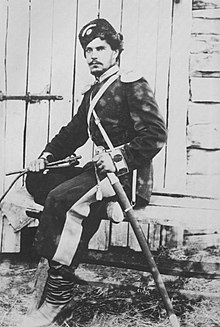
Orenburg Cossack, ca. second half of the 19th century
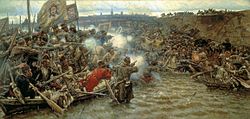
The Conquest of Siberia by Jermak, a painting by Vasily Surikov
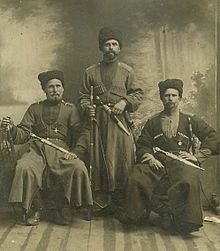
The clothing of the Kuban Cossacks (southern Russia) in the 19th century adopted many Caucasian elements such as the chocha

A Siberian Cossack, late 19th century.
Cossacks in the Second World War
Cossacks in the Wehrmacht
As at the time of the Russian Civil War, the Cossacks found themselves on both sides during the Second World War. Many Cossacks, among them a not inconsiderable part of the Cossacks living in exile, such as the former ataman Pyotr Krasnov, harboured open sympathies for National Socialist Germany because of their anti-Bolshevik attitude, which they regarded as a bulwark against Stalin and communism.
In the advance of the German Wehrmacht they believed they saw an opportunity to regain old rights and privileges and to be able to openly celebrate their faith in the Orthodox religion again. Therefore they offered their services to Hitler. At first, Hitler did not comply with their wishes, even though the Cossacks were not considered Slavic "subhumans" in the Nazi racial hierarchy, but rather a people descended from the Ostrogoths and thus at least partially "Aryan".
The first Cossack security and cavalry formations to be deployed on the German side emerged in the autumn of 1941. On 22 August 1941, the Soviet 463rd Infantry Regiment under Ivan Kononov, a Don Cossack, defected to the Wehrmacht almost in its entirety and was commissioned by Army Group Central as Cossack Division 600 for security tasks and for fighting partisans. The 18th Army of the Wehrmacht (Army Group North) decided that each division of the Wehrmacht, which was entrusted with occupation duties, should receive a Cossack hundred, whose special task would be the destruction of partisans. These formations, soldiers and officers, were initially formed entirely from the prisoner of war camps and defectors from the Red Army.
During the summer offensive of the Wehrmacht in 1942, Hitler approved the use of Cossack units not only in the fight against partisans, but also at the front. With the help of 25,000 volunteers, a large front-capable unit was to be formed. When the Wehrmacht had to withdraw from the Caucasus after the defeat at Stalingrad, the plan was dropped. However, there were about 20 Cossack units in battalion strength spread all over the Eastern Front in combat.
The 1st Cossack Cavalry Division, raised in Mława, Poland in the summer of 1943, numbered about 10,000 men. It was the first large Cossack unit in the East. The Cossacks of the reception camp Kherson in Ukraine, Cossacks from the Don, Kuban, Terek, Siberia, Transbaikalia and Ussuria formed the tribe of the division. The officer and non-commissioned officer corps was formed from former prisoners of war of the Red Army and from emigrant Cossacks of Western countries who had agreed to collaborate. The organizational form, armament, and equipment were the same as those of the East Prussian cavalry brigades. In September 1943 the division consisted of one regiment each of Siberian and Terek Cossacks and two regiments each of Don and Kuban Cossacks. Each regiment had 2,000 men, with 160 German soldiers as skeleton personnel. The division was subordinate to German Major General Helmuth von Pannwitz, who was elected by the Cossacks as the division's hetman.
Because there were concerns that the Cossacks would not fight reliably against their compatriots, the large unit was not deployed to the Eastern Front, but was ordered to Yugoslavia in the Belgrade area in September 1943, and placed under the command of the 2nd Panzer Army, Army Group F. The surrender of Yugoslavia in April 1941 and the simultaneous disintegration of the multi-ethnic state heralded one of the bloodiest and most sacrificial partisan wars in history. The fronts crisscrossed the country between the political power groupings. The Cossack regiments were given the task of attacking the partisans and driving them out of their bases, in addition to protecting the supply lines to Greece (including the ethnic Germans). The Yugoslav People's Liberation Army had long since grown from an initial 80,000 men to over 400,000 by the end of 1944. The mobility of the mounted Cossack units and their fighting courage brought the partisans however several times into heavy trouble. Within the framework of the "Rösselsprung" enterprise, two Cossack regiments distinguished themselves in the capture of Tito's headquarters in the mountains near Drvar, whereby the partisan leader only managed to escape capture by a stroke of luck at the last minute.
Helmuth von Pannwitz, who in the meantime had been appointed Lieutenant General, was finally in charge of the XIV Cossack Cavalry Corps of the Waffen-SS, which had grown into an army corps, consisting of the 1st Cossack Cavalry Division (commander Colonel von Baath), the 2nd Cossack Cavalry Division (commander Colonel Hans-Joachim von Schultz) and the 3rd Cossack Cavalry Division (commander Colonel Iwan Kononow). Cossack Cavalry Division (commander Colonel Hans-Joachim von Schultz), the Plastun Brigade (commander Colonel Iwan Kononow) as well as the 3rd Cossack Division, which was under construction, with a combat strength of more than 25,000 men. Already since the middle of 1944 there had been efforts to integrate the Cossack Division into the Waffen-SS. On 26 August 1944 there was a discussion between Himmler and Pannwitz. General von Pannwitz accepted a loose affiliation with the Waffen-SS in order to give his units access to heavier weapons and better equipment, and to retain further control over Cossack units in France. However, the command structures, uniforms as well as rank designations remained with the Wehrmacht. The 1st Cossack Cavalry Division became known for a large number of lootings, rapes, and shootings in the Yugoslav insurgency area.
Resettlement
Due to the retreat of the Wehrmacht in the East from 1943 on, many Cossack families were forced to leave their homeland. The German government assigned them new settlement areas in the Tolmezzo area, in the upper Italian province of Friuli, as a new "Cossackia". In the summer of 1944, about 35,000 Cossacks were evacuated from the East in 50 railway trains and settled in this area, where they were mainly used in the fight against Italian partisans until the end of the war.
"Lienz Cossack Tragedy."
→ Main article: Lienz Cossack tragedy
For various reasons, but above all to escape capture by the Red Army or Tito partisans, the Cossack Stans fled to Austria over the Plöcken Pass at the beginning of May 1945. In this way they reached the area of Upper Carinthia and East Tyrol. The headquarters were set up in Lienz, and thousands of soldiers, women, children and their horses were camped in the meadows and forests of the surrounding area.
The British Army delivered the Cossacks to the Red Army in Judenburg in late May/early June 1945. This was done on the basis of the agreements of the Yalta Conference in 1945, which provided for the repatriation of Soviet citizens, especially those who had worn German uniforms or collaborated with National Socialism. Among these, however, were also emigrants from the Tsarist Empire who were not Soviet citizens and therefore would not have had to be extradited. For most of the officers of the Cossacks the extradition meant the mostly immediately execution, the enlisted men disappeared predominantly in the Siberian penal camps, where many of them also perished. Von Pannwitz, Krasnow, Shkuro and nine other prominent Cossack leaders were brought to Moscow, sentenced to death in a treason trial and executed in January 1947.
Cossack units of the Red Army
Also on the Soviet side Cossack units, especially the Kuban and Terek Cossacks, formed an essential part of the mobile forces of the Red Army in the southern section of the Eastern Front. Already in 1936 the Red Army had begun to raise Cossack units again, which also wore the old Cossack costume. After the outbreak of war, volunteers from the traditional Cossack areas were called up to form four Cossack divisions (12th and 13th Kuban Cossacks, 14th and 15th Don Cossacks) which together formed the 17th Cossack Cavalry Corps of the Red Army. For its achievements, the corps was later elevated to the 4th Guards Cossack Cavalry Corps.
The wartime deployment of the Cossacks on the side of the Red Army certainly contributed to the fact that - in contrast to "unreliable" ethnic groups, such as Crimean Tatars, Volga Germans or Chechens - the Cossacks as a group no longer suffered systematic persecution by the Soviet leadership. Leaders of collaborators and anti-Bolsheviks were therefore charged as "White Guards" or "German agents," while the loyalty of Cossacks per se was not questioned. Nevertheless, in 1947 all Cossack units of the Red Army were disbanded and the Cossacks were thereafter largely pushed out of public consciousness.
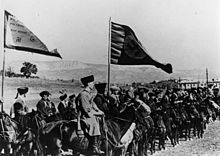
Cossack unit of the Wehrmacht
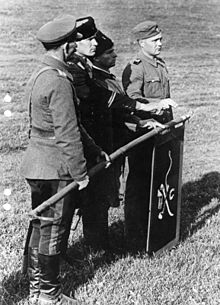
A Cossack takes an oath to Hitler

Kuban Cossacks at the Victory Day parade in Moscow in 1945
Questions and Answers
Q: What is the origin of the Cossacks?
A: The Cossacks are a group of nomadic East Slavic Orthodox Christian warrior people originating in the steppes of Ukraine. They derive their name from "Cuman cosac", meaning "free man".
Q: When did they first rise up?
A: The Ukrainian Cossacks first rose as a warrior group in the 15th century, in response to raids by Tatars and conquests by the Ottoman Empire.
Q: How did they expel Ottoman influence from Ukraine?
A: The Cossacks rebelled against the Ottoman Empire and were responsible for destroying its influence in the region. This led to them capturing many outposts in the Ukrainian steppes and creating an independent state known as a Cossack Hetmanate.
Q: What does 'Cossack' mean?
A: The term 'Cossack' literally means "free man". It was first used in 1395.
Q: Where are most well-known Cossacks from?
A: The most well-known Cossacks are from Zaporizhzhia (Ukraine) and Don, Terek, Kuban and Ural areas (Russia).
Q: What role did they play during Russian Imperialism?
A: On behalf of the Russian Imperial Empire, Cossacks conquered lands as far east as Siberia and even Alaska which they later sold to USA. They also subdued Kazakhstan, Uzbekistan, Turkmenistan, Kyrgyzstan and Tajikistan for Russia's empire. Additionally, they invaded Armenia on behalf of Armenians against Ottomans resulting in annexation of both Armenia and Azerbaijan into Russia's empire.
Q: How did they fare during Soviet times? A: During Soviet times, life for Cossacks was subject to Bolshevik attacks with their lands surviving several famines. In addition, some fought on both sides during World War II while others fought on behalf of Bolsheviks during Russian Civil War
Search within the encyclopedia